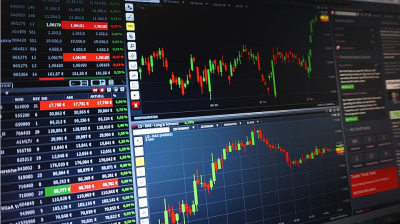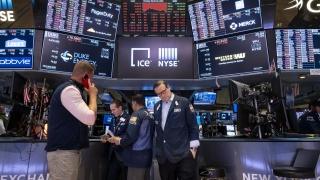Difference between revisions of "High Frequency Trading"
| Line 1: | Line 1: | ||
{{Nav-Bar|Topics##}}<br> | {{Nav-Bar|Topics##}}<br> | ||
[[File:HFT-blog header.png|400px|thumb|right|]] | [[File:HFT-blog header.png|400px|thumb|right|]] | ||
| − | + | High-frequency trading, or HFT, is a system that involves market data, algorithms, software and high-end powerful computers to make multiple trades per second. Traditionally, traders sit on trading floors and utilize hand signals to buy and sell stocks. However, with HFT on the rise, traders now rely on technology to analyze multiple markets and execute multiple trades simultaneously at very high frequencies. These platforms have increased transactions speeds relative to traditional trading. Furthermore, some traders have benefited from HFT as traders with faster execution speeds profit more than those who are slower. As HFT begins to take a larger share of the equity market, it is beginning to raise ethical concerns. | |
| − | + | ||
| − | High-frequency trading | + | |
== History == | == History == | ||
Revision as of 17:56, 27 March 2020
High-frequency trading, or HFT, is a system that involves market data, algorithms, software and high-end powerful computers to make multiple trades per second. Traditionally, traders sit on trading floors and utilize hand signals to buy and sell stocks. However, with HFT on the rise, traders now rely on technology to analyze multiple markets and execute multiple trades simultaneously at very high frequencies. These platforms have increased transactions speeds relative to traditional trading. Furthermore, some traders have benefited from HFT as traders with faster execution speeds profit more than those who are slower. As HFT begins to take a larger share of the equity market, it is beginning to raise ethical concerns.
Contents
History
- In 1602 The world's first stock exchange - Amsterdam Stock Exchange begins trading securities.
- In 1983 Bloomberg terminal comes out and it is the first computing system that provides real-time market information, which supports trading.
- In 1998 SEC authorizes high-frequency trading.
- In 2010 HFT accounts for 50% of the equity market.
- In 2012 the share of HFT increase to 70% of US equity trading.
- In 2014 HFT starts supporting bitcoin. [1]
Features
High-frequency trading firms are market makers and provide liquidity to the market. They narrow Bid-ask spreads which lead to lower trading costs.
Liquidity
Liquidity is the ability of an asset to be sold on the market, the easier to sell, the higher the liquidity it has. When making an investment, investors take the liquidity of assets into consideration. In most cases, investors prefer high liquidity assets. The amount and volume of the trades using the HFT platform ensure a liquid market. Thus HFT improves market liquidity and eases the effects of market fragmentation. As HFT trades can make up as much as 70% of the trading volume on a given day, investors have a greater ability to be matched up with a counterparty. [2]
Market-making
Market making means placing an order to sell (ask) above the current market price or a buy limit order (bid) below the current price to capture the bid-ask spread (the difference between the selling price and purchase price) and make a profit. This strategy provides market liquidity and makes sure traders can always move funds.
Bid-ask Spread
Investors face a bid-ask spread which is the difference between the selling price and purchase price. HFT narrows the spread due to the ability to create liquidity. The small spread means an investor can purchase equity with a price that only a little bit higher than the selling price. Hence, HFT provides low trading costs.
Latency Arbitrage
Latency arbitrage means getting an advantage by being faster. The market has bid and ask prices. The bid price is the highest price a buyer will pay for a security, and the ask price is the lowest price a seller willing to sell the security. Whenever an order comes to market at a good price, the fastest trader can take it. One of the major benefits of HTF is the speed of trading. [3] A number of theoretical models use HFTs to motivate their informational structure. Martinez and Rosu (2013) and Foucault, Hombert, and Rosu (2013) model HFTs receiving information slightly ahead of the rest of the market. HFTs predict price changes over horizons of less than 3 to 4 seconds.[4] The high-frequency platform also allows traders to profit by making a sheer number of trades that would be impractical for a manual trader. Through algorithms, a high-frequency trader can conduct enough trades in enough volume in a short time to react to the market.
High Frequency Trading Firms
Chicago Trading
Virtu Financial
Citadel LLC
Ethical Concerns
Bias
Algorithms were written by humans so it cannot avoid bias. It may generate bias-driven orders it unsophisticated trader written the algorithms. [5]
Market Manipulation
HFT can give traders an unfair advantage if they engage in market manipulation. A trader would be driving interest in a lightly-traded stock from which he or she would profit through market manipulation. On Oct. 16, 2014, The Securities Exchange Commission charged a New York-based trading firm of manipulating the closing price of thousands of Nasdaq-listed stocks from June to December 2009. By using an algorithm, Athena Capital Research made its trading at the end of the trading day in order to impact the stock prices. “The massive volumes of Athena’s last-second trades allowed Athena to overwhelm the market’s available liquidity and artificially push the market price—and therefore the closing price—in Athena’s favor. Athena was acutely aware of the price impact of its algorithmic trading, calling it ‘owning the game’ in internal e-mails,” the SEC wrote in a release.[6]
Unfair to Small Investors
Hedge Fund companies take advantage of the fast computing system, but individual investors, brokerage firms, or small institutions without access to the expensive computing facilities become harder and harder to gain from the market. According to estimates, the trading volume on U.S exchanges executed by high-frequency computers range from 50 percent to 73 percent. Market research firm, IBIS World, estimated that the high-frequency trading industry is a $29 billion enterprise. [7]
Reference
- ↑ Taylor, Cindy, https://www.fa-mag.com/news/history-high-frequency-trading-47355.html, “The History of High Frequency Trading in an Infographic”, Financial Advisor, March 26, 2017. Retrieved 2020-03-20
- ↑ https://knowledge.wharton.upenn.edu/article/the-impact-of-high-frequency-trading-manipulation-distortion-or-a-better-functioning-market/ “The Impact of High-frequency Trading: Manipulation, Distortion or a Better-functioning Market?”, Knowledge @ Wharton, September 30, 2009. Retrieved 2020-03-12
- ↑ https://www.investopedia.com/ask/answers/09/high-frequency-trading.asp
- ↑ https://www.econstor.eu/bitstream/10419/154035/1/ecbwp1602.pdf
- ↑ https://pdfs.semanticscholar.org/8328/7932d8637249b12720aa7c11b50565bda1b2.pdf
- ↑ https://www.cnbc.com/2014/10/16/sec-accuses-high-frequency-trading-firm-of-manipulating-closing-price-of-thousands-of-stocks.html
- ↑ https://www.digitalethics.org/essays/ethics-high-frequency-stock-trading

